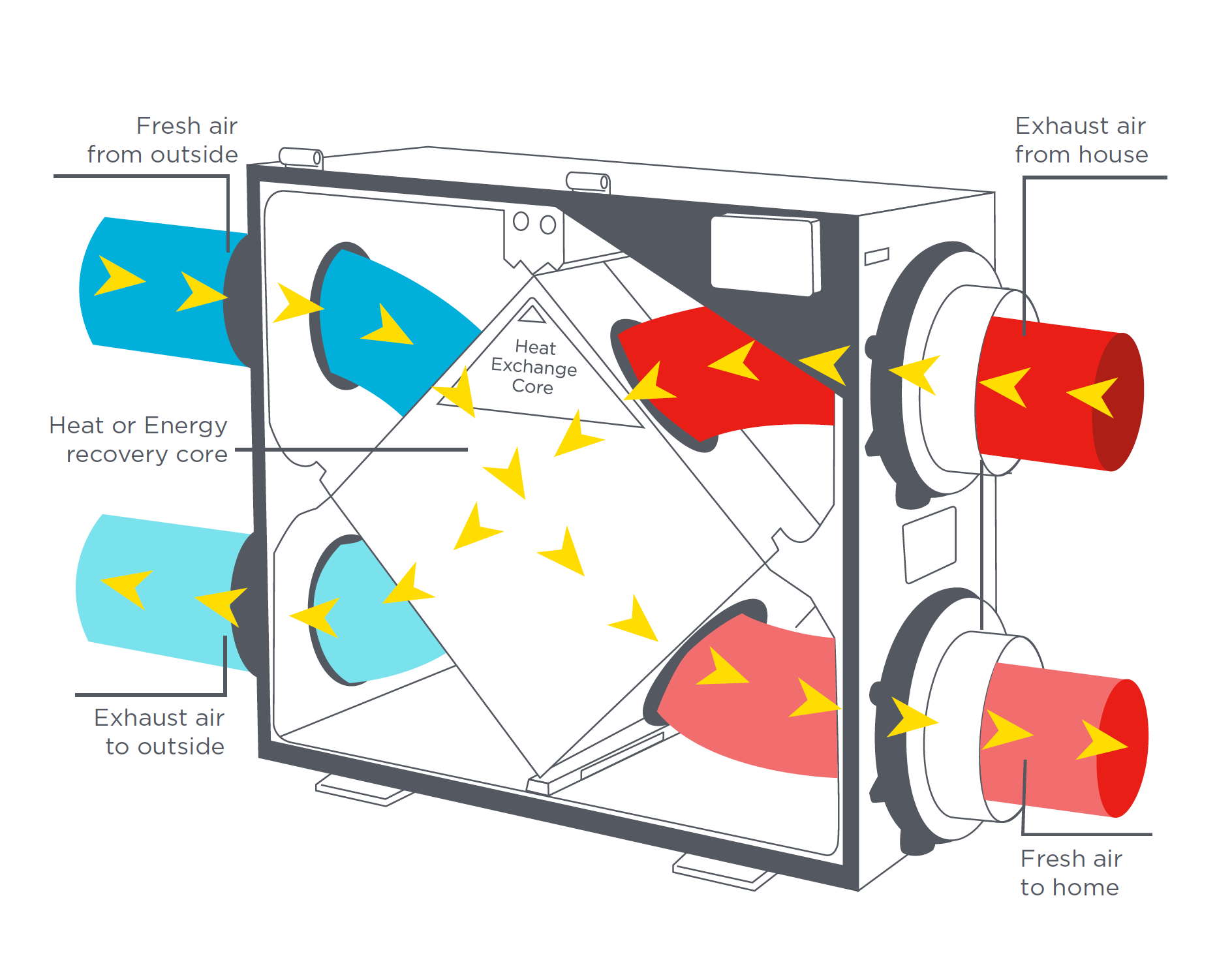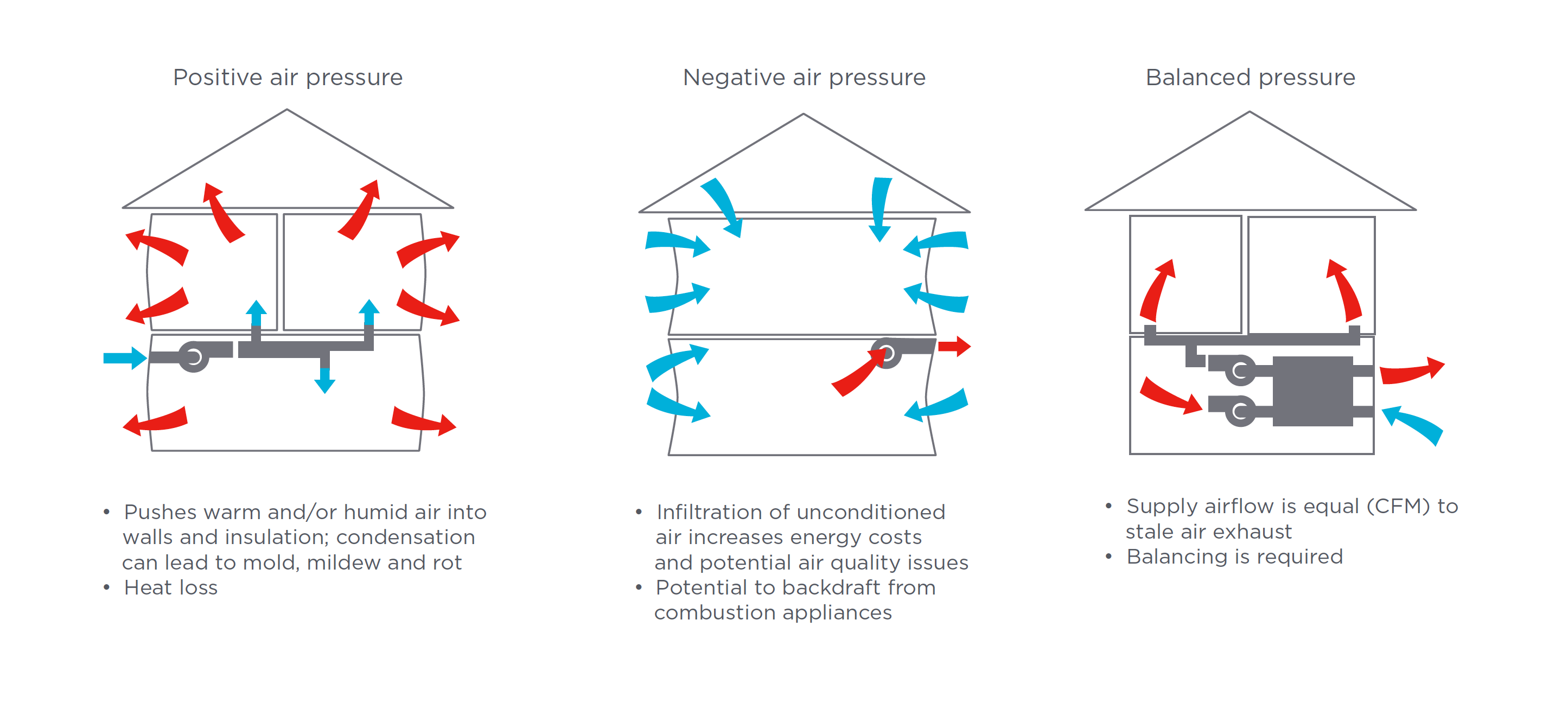High-performance, energy efficient homes built today are comfortable, have affordable energy costs and provide superior indoor air quality. Because of their tight construction, these homes require whole-home ventilation systems operating year-round.
Why do I need a ventilation system?
Older homes generally have natural air leakage through cracks and holes in the building and therefore do not need a dedicated ventilation system. On the other hand, your new home will have high levels of insulation and use airtight construction to minimize air leaks, and therefore needs a mechanical system to ensure stale indoor air is replaced with fresh air from outside. The national building code requires mechanical ventilation in all new homes.
Can a home be too airtight? The answer is no. Airtight construction prevents uncomfortable drafts and prevents humid indoor air from reaching cold wall cavities and attics. The tighter a home, the more important it is to have and use a properly installed ventilation system to ensure healthy indoor air quality and control indoor moisture levels.
Whole-home ventilation systems
There are three main (or common) types of whole home ventilation systems: air exchangers, heat recovery ventilators (HRVs), and energy recovery ventilators (ERVs). The following table lists the differences between these three systems. In Nova Scotia, the majority of new homes have an HRV.

Common heat recovery ventilator design
Pros & Cons
Air Exchanger
Pros:
Exchanges stale air from inside with fresh outside air
Cons:
Heat is lost through the exchange of air
Does not control moisture levels
HRV
Pros:
Exchanges stale air from inside with fresh outside air
Heat from the outgoing air is recovered and used to heat the incoming air, reducing heat loss
Cons:
Limited ability to control moisture in the summer
ERV
Pros:
Exchanges stale air from inside with fresh outside air
Heat from the outgoing air is recovered and used to heat the incoming air, reducing heat loss
Transfers moisture between the incoming and outgoing air
Installation
Location – The main unit of a ventilation system should be installed in a heated space and typically hangs from the ceiling of a utility room or closet. Short lengths of flexible ductwork will connect the unit to the main ductwork. It should be installed so that there is access to a dedicated electrical circuit and a drain for condensation and also that there is enough clearance to open the front of the unit to service filters and clean the core.
Dedicated ductwork – Poor ductwork will hurt the performance of even the best ventilation unit and therefore ducts should be properly sized and as short as possible, straight and direct, made from sheet metal, and provide fresh air to every bedroom and the main living areas of the home. Intake and exhaust ducts should be insulated to avoid condensation and minimize efficiency losses.
Heating system ductwork – Your heating system ductwork can sometimes be used for ventilation purposes, but is not an ideal solution as heating ducts are designed to carry much larger volumes of air. This can make it difficult to ensure that adequate fresh air is evenly distributed throughout the home, particularly if the heating system’s fan isn't on.
Outside air intake – The location of the system’s outside air intake affects the quality of air brought into the home. The system’s intake and exhaust vents should be at least six feet apart and be high enough off the ground to avoid being covered by drifting snow. Potential issues to consider when choosing a location for the air intake include smoke from nearby wood burning, automobile exhaust fumes, dryer exhausts and cooking odours from a BBQ or range vent.
Additional Ventilation – New homes should have a kitchen range hood that exhausts directly outside. Because cooking grease could clog the system’s core, the ventilation system shouldn't be connected directly to a kitchen range hood and the kitchen exhaust shouldn't be located close to the stove. Builders may also install separate shower exhaust fans that are vented outside or connect bath fans into the exhaust ductwork to boost ventilation when showering.
Balancing – Ventilation systems are designed to operate in a balanced condition with equal exhaust and supply air flows to avoid air pressure differences, moisture problems and hazardous back-drafting conditions with combustion equipment like furnaces, fireplaces or gas stoves. A new system should be balanced when it is installed.
During construction – To prevent debris and dust from entering the system, tape should be applied over all intakes and exhausts during construction. It is much easier to prevent the system from becoming contaminated than it is to try to clean it out afterwards.

Operation
Most ventilation systems have a control (humidistat) that regulates the high speed operation of the system. More elaborate humidistats can also be installed to control various other features. Settings for your ventilation system should vary depending on the season and the outside air temperature. Optimal settings will also depend on how your home is built and your lifestyle. If you have a HRV it will recover most of the heat in the air being exhausted, which is the major cost of ventilation.
According to Health Canada, a house should maintain a humidity of 30% to 40% during winter, and up to a maximum of 55% in summer.
Note: Setting the maximum humidity setting too low could result in excessive operation and energy use. Setting the controls too high may result in condensation. If excessive window condensation occurs, reduce setting to a lower level.
For more information on operating, maintaining, and troubleshooting your ventilation system, check out Natural Resource Canada’s Guide to Heat Recovery Ventilators.


